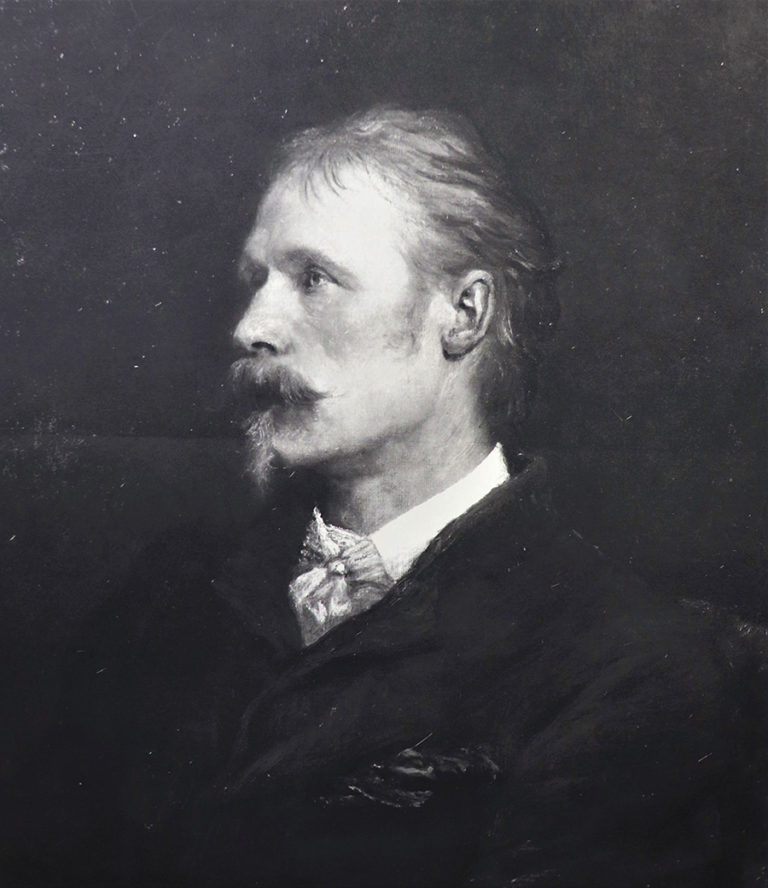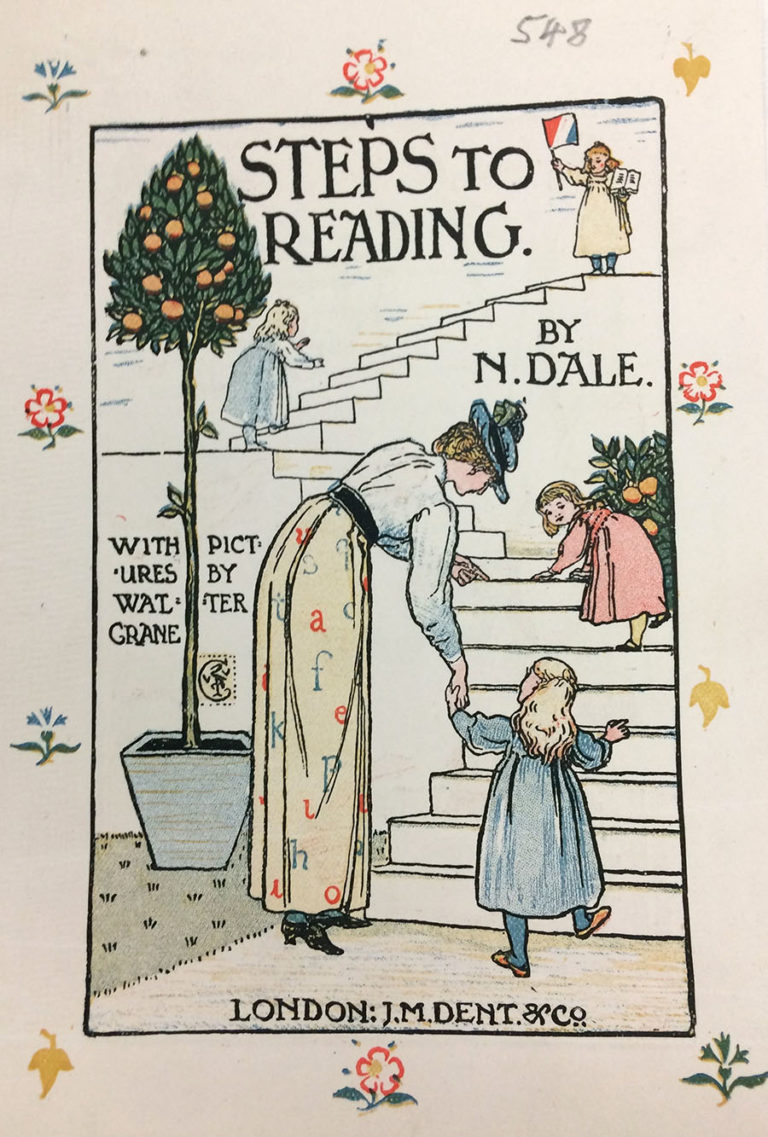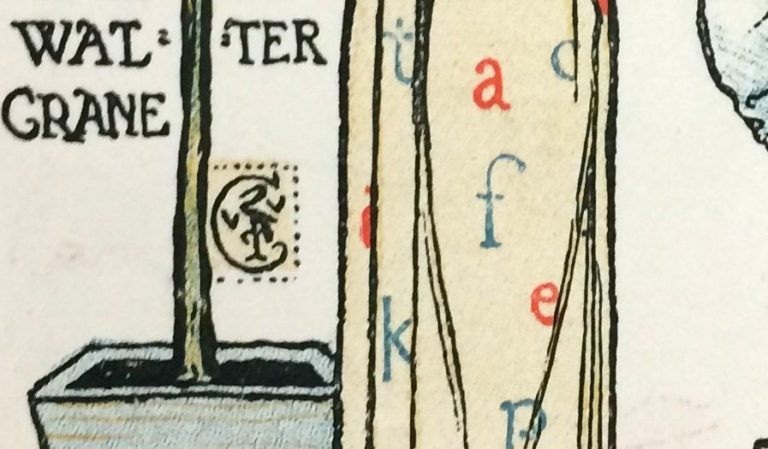Walter Crane (1845-1915) was an artist and designer, a prolific book illustrator and leading figure of the Arts and Crafts movement. His 175th birthday on 15 August is an opportunity to look at some examples of his work from the intellectual property records held at The National Archives.
Crane is perhaps best remembered for his children’s book illustrations. Along with his contemporaries, Randolph Caldecott and Kate Greenaway, he transformed the genre of the Victorian children’s book. His beautifully decorated, imaginative, richly illustrated books became prized objects for middle- and upper-class families to present to their children, earning him the nickname the ‘academician of the nursery’ 1.

His design work also connects him to the decorative arts of ceramics, wallpaper and embroidery, among others. He was a founding member and the first president of the Arts and Crafts Exhibition Society (1887-90), a member of and illustrator for the Socialist League, Vice President of the Healthy and Artistic Dress Union, Director of Design for the Manchester School of Art (1893) and principal of the Royal College of Art (1898).
As you can see, a blog post would hardly do justice to his life and career, so I have chosen to focus on samples of his artwork for a book, published in 1899, used for teaching a new method of learning to read and which we hold in our copyright records.
Crane’s illustrations and the Arts and Crafts movement
At the age of 13, Walter Crane was apprenticed to William James Linton, master wood engraver and also political activist. Linton was a member of the Chartists and was an early influence on Crane’s socialist outlook.
Learning the technique of wood engraving meant that Crane could begin a career in book illustration and achieve a high level of craftsmanship in his work in comparison with those using newer technologies. Starting off as an independent illustrator, Crane was soon commissioned by the printer Edmund Evans for his yellow-back book series and then, in 1865, by George Routledge to create a series of toy-books 2.
Crane was not complimentary about this type of book, writing:
‘The books for babies, current at that time […] of the cheaper sort called toy books were not very inspiriting. These were generally careless and unimaginative woodcuts, very casually coloured by hand, dabs of pink and emerald green being laid on across faces and frocks with a somewhat reckless aim.’ 3
Crane’s illustrations by contrast, were highly decorative and imaginative, inspired in part by Japanese woodcuts. They also carried patterns and motifs, as well as designs for interiors, in keeping with those promoted by the Arts and Crafts movement.

The aims of the movement, which emerged in the Victorian era, were to rebel against mass-manufactured goods with a return to small workshop production methods, and to raise the status of everyday objects to match that of fine art.
Fine arts, including painting and sculpture, had traditionally been viewed as the highest form of art and craftsmanship, with the power to educate and guide taste.
In the eyes of Crane and his fellow Arts and Crafts artists and designers, an object like a chair or a book, could carry out the same role as a painting, if it was designed and made according to the right principles.
With the help of publishers like George Routledge, Macmillan and J M Dent, Crane was to transform the toy book genre and made children’s books into works of art.
Nellie Dale and ‘Steps to Reading’ (1899)
Books to teach reading are known as primers and the first English primers existed as far back as the 16th century 4. By the Victorian era, primers were based on the alphabet system where children were encouraged to read aloud the names of letters.
Nellie Dale (1865-1967) was a Wimbledon-based school teacher who pioneered a new system of teaching children to read by drawing connections between the visual with the written form of the word.
This approach closely matched Walter Crane’s own approach, who believed in the power of the visual arts as a tool for communication. He thought that ‘Every child, one might say every human being, takes in more through his eyes than his ears, and I think much more advantage might be taken of this fact.’ 5 By the time he worked with Dale, he had been producing illustrations for children’s books for more than 35 years.

Dale’s system was devised using a phonic method of coloured letters to gradually familiarise children to sounds of words 6. This method can be seen in ‘Steps to Reading’, published as part of ‘The Walter Crane Readers’ by J M Dent. Crane’s artworks for the book were registered for copyright in 1899 and can be viewed at The National Archives in series COPY 1/158.

The illustrations in the book consist of charming, pastoral scenes of children playing. Crane, who enjoyed a picturesque childhood in Torquay, Devon, described similar scenes from his own early years, with full days spent ‘shrimping’ on the sands, flying kites, sailing toy ships and catching butterflies 7.
These images sit alongside more surrealist imagery such as two pigs driving a horse and cart.
It’s the design of the frontispiece that shows off Crane’s understanding and experience in book design. Incorporating elements of the coloured letter learning technique in the decoration of the woman’s skirt, and the device of the staircase to indicate the progression of the learner, is a real triumph of harmony in decoration and function.

Another page shows Crane’s use of decoration as part of the page layout. The stem of a lily climbs the centre of the page, again illustrating the concept of progression or growth of the reader as they learn new sounds.
In these artworks you can also catch a glimpse of Walter Crane’s signature. He signed his works using the symbol of a small crane inside a letter ‘C’ with a rectangular border. In some instances the symbol has been seen to appear carried in the beak of a crane, like a letter.

Final notes
Nellie Dale would later move the publication of the ‘Readers’ series to George Philip & Son Limited and they became known as the ‘Dale Readers’. Although Dale’s method for teaching children how to read is today considered overcomplicated, the books retain their appeal due to their beautiful and amusing illustrations provided by Walter Crane 8.
Crane’s success in children’s book illustration came down to his understanding of how all of the elements of the book as an object, including its content, decoration and manufacturing contributed to the child’s experience of it. He achieved this by applying the principles of the Arts and Crafts movement, where form followed function, and by using a combination of decorative art and pictorial representations to illustrate them.
See also:
Arts and Crafts at the archives, by Julie Halls
Notes:
- ‘Rhyming Pictures: Walter Crane and the Art of Reading’, Dr Grace Brockington, British Academy Review, issue 10, [accessed 13 August 2020] ↩
- Walter Crane Archive at University of Manchester Library, Archives Hub, [accessed 13 August 2020] ↩
- Walter Crane, Of the Decorative Illustration of Books Old and New, 3rd ed. [accessed 13 August 2020] ↩
- ‘The English Primer – a circular journey’, Rita M Bates, Internationale Schulbuchforschung, Vol. 19, No.3., [accessed online 13 August 2020] ↩
- Crane, ‘Of the Decorative Illustration of Books Old and New’ ↩
- Brockington, British Academy Review ↩
- Walter Crane, ‘An Artist’s Reminiscences’ (1907), The Macmillan Company, pp.22-26 ↩
- Bates, Internationale Schulbuchforschung ↩

TRULY FASCINATING
very interesting indeed. Walter Crane’s cover for Steps To Reading is SO good. I see NellieDale lived to be 102!
I have Walter Crane’s copy of Thomas Bewick’s, A History of British Birds; 2 volumes 1804. The work has Crane’s bookplate in each volume, with the inscription: ‘This book was presented to me by William Russell WC'[Walter Crane’s initials].
I do wonder how much Bewick’s wood engravings influenced Crane? Is it a stretch, I further wonder; to think William Russell could be the artist, William Russell Flint.
I was greatly interested in the piece about Walter Crane. I have just read a book about his work and along side this piece nowhere does it mention Walter Crane’s stained glass window designs. I realise the work was limited but at Holy Trinity/Hull Minster we have an outstanding window of psalm 148. He worked on this with James Silvester Sparrow and it contains the crane hieroglyph with a sparrow and the date of 97. The ‘Birds of a Feather’ design. A further window in the church was designed by Crane but only completed four years after his death, by Frederick Christmas of London. Unfortunately there is no comparison in the two pieces. Crane and Sparrow worked together in 1893 on windows for the ‘Ark of the Covenant’ church in Stamford Hill.
Immensely interesting
Very interesting, thank you.
What a delightful article about Walter Crane!